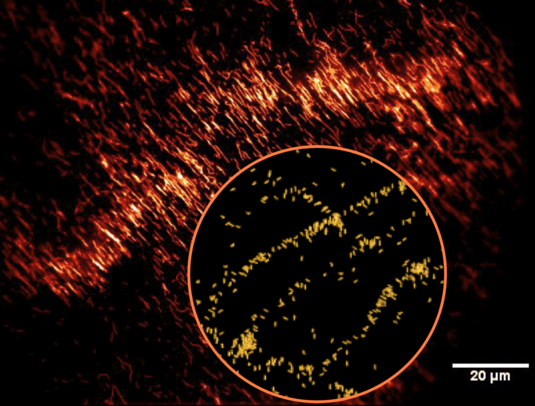Modeling swarms with agent-based simulations
Volker Schaller, Christoph Weber, Christine Semmrich, Erwin Frey and Andreas Bausch
The emergence of collective motion such as exhibited by systems ranging from flocks of animals, self-propelled microorganisms or the cytoskeleton is an ubiquitous and fascinating self-organization phenomenon. All these systems display similar phenomenologies, even though the particular underlying physics is genuinely different, ranging from hydrodynamic interaction to steric or inelastic repulsion, attraction, to more complex interactions mediated by linker proteins or molecular motors. Examples for similarities are the inherent polarity of the constituents, a density-dependent transition to ordered phases or the existence of huge density fluctuations. This suggests universal organizing principles underlying pattern formation; an idea followed by hydrodynamic models valid on large scales.
 We constructed a model to account for the emergence of collective motion in high-density motility assays. The high-density motility assay consists of highly concentrated actin filaments propelled by immobilized molecular motors in a planar geometry. Above a critical density the filaments self-organize to form coherently moving structures with persistent density modulations such as clusters, swirls and interconnected bands. These polar-nematic structures are long-lived and can span length scales orders of magnitudes larger than their constituents.
We constructed a model to account for the emergence of collective motion in high-density motility assays. The high-density motility assay consists of highly concentrated actin filaments propelled by immobilized molecular motors in a planar geometry. Above a critical density the filaments self-organize to form coherently moving structures with persistent density modulations such as clusters, swirls and interconnected bands. These polar-nematic structures are long-lived and can span length scales orders of magnitudes larger than their constituents.
The agent-based simulations enable a backtracking of the assembly and disassembly pathways to the underlying local aligning interactions as well as an understanding of the patterning mechanism. The presented minimal model may even provide new insights into the rich class of collective motion present in the broad class of active fluids and self-propelled particles.

